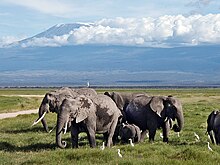Amboseli National Park: Difference between revisions
Pennmuseum (talk | contribs) |
|||
| Line 51: | Line 51: | ||
{{commonscat|Amboseli National Park}} |
{{commonscat|Amboseli National Park}} |
||
* [http://www.kws.org/kws/parks/parks_reserves/AMNP.html Kenya Wildlife Service – Amboseli National Park] |
* [http://www.kws.org/kws/parks/parks_reserves/AMNP.html Kenya Wildlife Service – Amboseli National Park] |
||
* [http://www.youtube.com/watch?v=XwbvUdG4MtU&feature=player_embedded Penn Museum Archival Video] |
|||
* [http://elephanttrust.org/ Amboseli Trust for Elephants] |
* [http://elephanttrust.org/ Amboseli Trust for Elephants] |
||
* [http://www.kenya-information-guide.com/amboseli.html] |
* [http://www.kenya-information-guide.com/amboseli.html] |
||
Revision as of 18:52, 18 May 2011
| Amboseli National Park | |
|---|---|
| Lua error in Module:Location_map at line 526: Unable to find the specified location map definition: "Module:Location map/data/Tsavo national park map en.png" does not exist. | |
| Location | Rift Valley Province, |
| Nearest city | Nairobi |
| Area | 392 km² |
| Established | 1974 as a national park (as a reserve in1906) |
| Visitors | 120,000 (estimated) (in 2006) |
| Governing body | Kenya Wildlife Service, Olkejuado County Council and the Maasai community |
Amboseli National Park, formerly Maasai Amboseli Game Reserve, is in Kajiado District, Rift Valley Province in Kenya. The park is 39,206 hectares (392 km2; 151 sq mi)[1] in size at the core of an 8,000 square kilometres (3,100 sq mi) ecosystem that spreads across the Kenya-Tanzania border. The local people are mainly Maasai, but people from other parts of the country have settled there attracted by the successful tourist-driven economy and intensive agriculture along the system of swamps that makes this low-rainfall area (average 350 mm (14 in)) one of the best wildlife-viewing experiences in the world. The park protects two of the five main swamps, and includes a dried-up Pleistocene lake and semi-arid vegetation.

140 kilometres (87 mi) South of the capital city Nairobi, Amboseli National Park is the second most popular national park in Kenya after Maasai Mara National Reserve and the visit can easily be done in a weekend.
In 1883, Joseph Thompson was the first European to penetrate the feared Maasai region known as Empusel (meaning 'salty, dusty place' in Maa). He, too, was astonished by the fantastic array of wildlife and the contrast between the arid areas of the dry-lake bed and the oasis of the swamps, a contrast that persists today.
Amboseli was set aside as the 'Southern Reserve' for Maasai in 1906 but returned to local control as a Game Reserve in 1948. Gazetted a National Park in 1974 in order to protect the core this unique ecosystem, it was declared a UNESCO Man and the Biosphere Reserve in 1991. The park earned $ 3.5 m (€ 2.9 m) in 2005. On September 29, 2005, Kenyan President Mwai Kibaki declared that control of the park should pass from the Kenya Wildlife Service to the Olkejuado County Council and the Maasai tribe. Some observers saw this as a political favor in advance of a vote on a new Kenyan constitution: legal challenges are currently in court. The degazetting would divert park admission fees directly to the County Council with questionable spread of benefits to the Maasai immediately surrounding the park. It would set an unfortunate precedent that could jeopardise the status of other parks in Kenya.
The park is famous for being the best place in Africa to get close to free-ranging elephants.[2] Other attractions of the park include opportunities to meet Maasai and spectacular views of Mount Kilimanjaro, the highest free-standing mountain in the world.
Amboseli offers some of the best opportunities to see African animals because its vegetation is sparse due to the long dry months. Amboseli National Park is home to wild animals, which include the African elephant, buffalo, impala, lion, cheetah, hyena, giraffes, zebra, wildebeest among other African animals. There is also a host of Kenya birds, both large and small, to see if you keep your eyes open and stop at every sighting.
When you arrive at the park, the warden will give you several common sense rules: do not get out of your vehicle, except at designated spots; do not harass the animals in any way; keep to the tracks; no off-road driving; and remember that the animals always have the right of way. The roads in Amboseli have a loose surface of volcanic soil that is dusty in the dry season and impassable in the wet season.
There is a small airport in Amboseli, the Amboseli Airport (HKAM).
